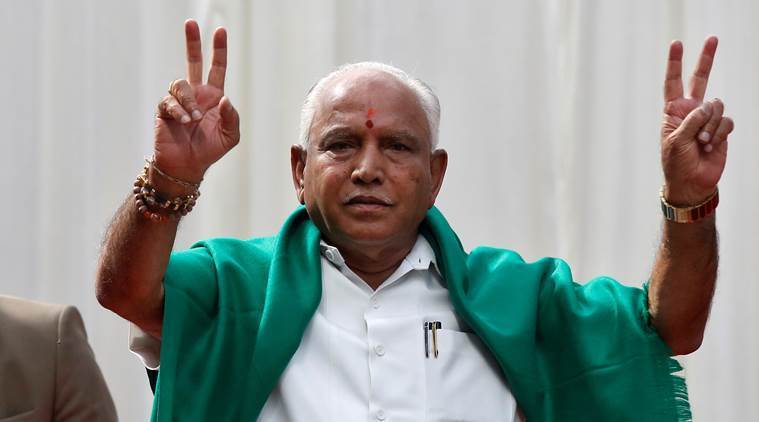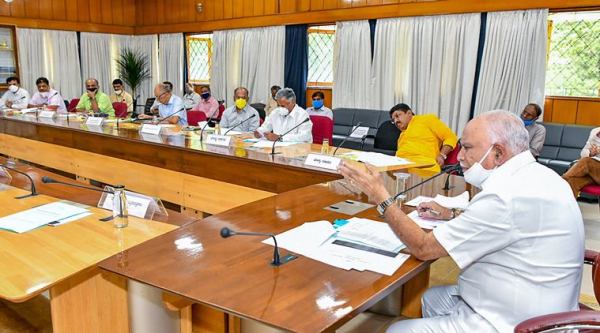 Karnataka Chief Minister B S Yediyurappa. (File Photo)
Karnataka Chief Minister B S Yediyurappa. (File Photo)
Karnataka Chief Minister B S Yediyurappa speaks to Liz Mathew about the state’s strategy for the battle against COVID-19, how it responded to the crisis and the way forward.
What has been Karnataka’s experience with the battle against coronavirus? What are the factors that kept the number of cases down?
We managed to keep the infection numbers down and limit collateral damage mostly because we had our response worked out from the beginning. Our government has been at the forefront of developing and implementing measures. To ensure the situation is monitored and all decisions are implemented with speed, we set up a task force under my direct monitoring. Its members were ministers heading ministries that would be constantly involved in the fight against the pandemic. This helped cut delays. Karnataka was probably the first state to set up a COVID-19 War Room that was responsible for keeping tabs on all counter-pandemic teams and activities.
What aspects did you focus on while strategising the fight?
We focused on aggressive contact tracing and enforcing the lockdown. We also raced to set up a war room to ensure 24X7 monitoring and reporting. We set up a well-oiled administrative machinery with 17 committees, each headed by a senior IAS officer of additional chief secretary rank to look into various tasks.
Don’t miss from Explained: Covid-19 vaccine: search, progress
Karnataka was quick off the block and started screening international air passengers as early as January 20. We have screened 2 lakh passengers.
 Bengaluru: Karnataka CM BS Yeddyurappa during a meeting, in Bengaluru. (PTI)
Bengaluru: Karnataka CM BS Yeddyurappa during a meeting, in Bengaluru. (PTI)
How was technology used in putting up infrastructure to fight the pandemic?
Karnataka government is pioneering use of technology and innovation to fight COVID-19. We responded innovatively to challenges of scale and speed by taking the technology route to train thousands of doctors and nurses in the shortest possible time. The Tele ICU Unit monitored real-time patient data and advised doctors in COVID hospitals. The task force has relied on police leg work, traffic video camera-feeds, drone monitoring and mobile phone data to effectively trace contacts of confined patients and monitor quarantined citizens. We also developed apps including “Corona Watch” to monitor home quarantined citizens, which helped free up municipal and police team members for other activities…
Our war room in Bengaluru has all the makings of a Security Operations Center, and functions much like it. Tracking various teams — law and order, medical teams on the field, designated hospitals, quarantined patients and the municipal staff’s daily updates on disinfecting and overseeing the home quarantined citizens, and even live-streamed drone footage. Manned by a dedicated team of nearly 25 round-the-clock and supervised by two IAS officers, the war room has hotlines to the task force and other entities like police and designated hospitals.
What is the impact of lockdown on Karnataka’s economy?
If it were not for the lockdown, we would have been staring at huge numbers of COVID-19 cases and a health crisis. Many states saw their first cases a week after Karnataka, but our state has since reported fewer cases and fewer mortalities than most. More telling is the death rate per million, which in Karnataka is 0.32, lower than the national average of 0.78 and way below Maharashtra’s 3.27 (as of April 28).
The most adverse impact of the lockdown was felt by migrants and those below the poverty line. In keeping with the motto of the Prime Minister, “Jaan bhi, jahaan bhi”, we opened 1,984 relief camps and accommodated 1,44,954 migrants in them. Rs 2,000 was credited to the accounts of all construction workers, including migrants.
The state government also involved NGOs and started one of the largest state-supported feeding projects — providing daily food to 3,56,201 people. To ensure food security, we quickly moved to provide free rice, dal and other rations for three months to 1.9 crore AAY and PHH ration card holders. To provide financial assistance, we went ahead with direct benefit transfer of Rs 500 (as first instalment) to 13.98 lakh beneficiaries as part of the PM Garib Kalyan Yojana. Thirty-one lakh families were given free LPG cylinders. Nearly 7.75 lakh litres of milk is being distributed free to the poor daily.
Which sectors and industries will have to be given stimulus by the government?
A department-wise comprehensive plan has been prepared. Agriculture and allied sectors have been given utmost importance. The state government has procured 3.8 lakh MT of produce from farmers and supplied it to food processing industries. Government of Karnataka through Karnataka Building and Other Construction Workers (BOCW) Welfare Board is providing livelihood allowance of Rs 1,000 per month per registered worker and arranging temporary boarding and lodging facilities for the needy (about 1.4 lakh) migrant workers (including unorganised non-BOCW). The government has set up a 16-member task force to deal with issues related to wage and retrenchment…
Read | Gujarat records 27 deaths, complete lockdown in Ahmedabad, Surat
What is the roadmap to restart economic activity in Bengaluru?
Bengaluru has done really well in containing the spread of the virus… Since most of the industrial areas, IT parks etc are outside the containment zones, the government will take all precautionary measures and restart economic activity in Bengaluru except in containment zones.
Former CM Siddaramaiah said farmers’ issues were not addressed. Your comment?
The government has not taken its eyes off the situation of farmers. Smaller task forces have been set up to resolve farmers’ grievances quickly. Issues such as market linkages, obtaining seeds and fertilisers are being managed with the urgency so desired. The state government has leveraged its chain of 480 horticulture department outlets and 300 mobile units to procure farm produce directly from farmers and collectives and take them to consumers.
Many states have asked the Centre to take steps to help them overcome their perilous fiscal positions. What is Karnataka’s suggestion?
Every state is facing major challenges… The financial help already by the Centre through NRHM, SDRF, PM Garib Kalyan Yojana have immensely helped people of Karnataka. We also have sought support… I am sure Centre will extend all necessary support to state governments.